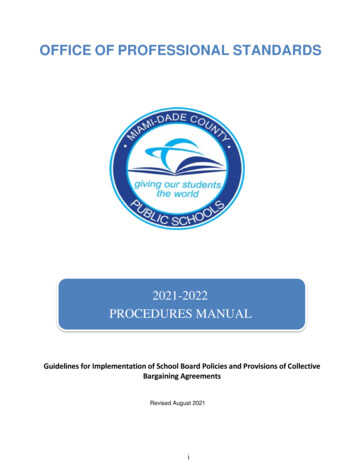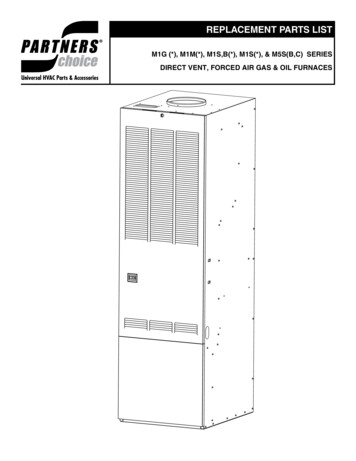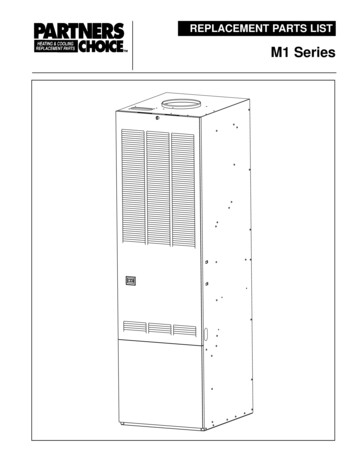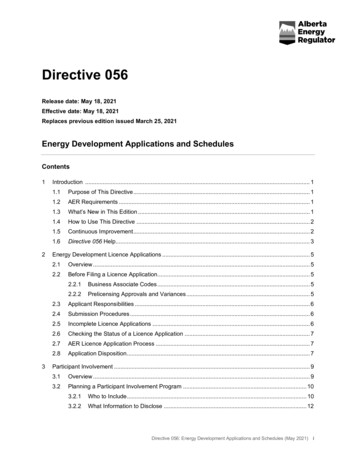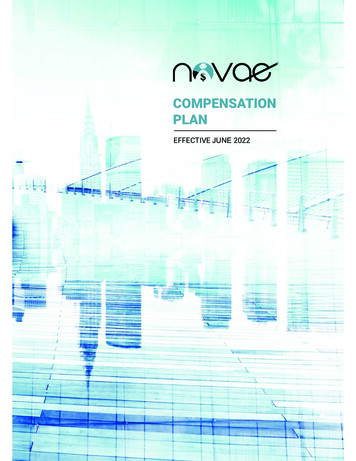
Transcription
DOCUMENT RESUMESP 005 400ED 056 995AUTHORTITLEINSTITUTIONSPONS AGENCYSarthory, Joseph A.Educational Renewal: An Inclusive, Process-OrientedModel of Leadership Development. An Occasional PaperDeveloped by the Project Kansas 76 Staff,Kansas State Dept. of Education, Topeka.Office of Education (DHEW), Washington, D.C. Bureauof Educational Personnel Development.PUB DATENOTE7120p.EDRS PRICEDESCRIPTORSMF- 0.65 HC- 3.29*Consortia; *Cooperative Programs; *EducationalChange; *Interinstitutional Cooperation; *LeadershipTrainingABSTRACTThis paper describes a leadership development modelwhich departs radically from the traditional leader preparationprograms. Leadership is perceived not as a complex of skills andcharacteristics accruing to an individual but as the initiation andmaintenance of an ongoing process of self and organizational renewal.The process envisioned involves a consortium of various educationagencies, including university and state department personnel,teachers, administrators, students, and community members. This broadinvolvement, plus the capability to institutionalize the processthrough program approval, certification, and accreditation proceduresoffers real promise for significant and lasting relevance andaccountability. The renewal process would occur simultaneously in allthe participating agencies, which would ensure continuingadaptability and flexibility to changing needs on the part ofeducators and those who prepare and certify them. The model offers anopportunity to institutionalize planned change across a broadspectrum from preparation to practice. (MBM)
ikkACT KANSAS 76&INCEPT PAPER.U S DEPARTMENT OF HEALTH,EDUCATION & WELFAREOFFICE OF EDUCATIONTHIS DOCUMENT HAS BEEN REPRODUCED EXACTLY AS RECEIVED FROMTHE PERSON OR ORGANIZATION ORIGINATING IT POINTS oF view IDR OPINIONS STATED DO NOT NECESSARILYREPRESENT OFFICIAL OFFICE OF EDUCATION POSITION OR POLICYCDLaUCATIONAL EENEWAL:.0DEL ,9:1?::::LEARSEti ,,,pEVELOPMEN41444#0,itt-tiEL-71
Project. Kansas 16 is a cooperative effàrt. to 'identaud developParticipatingnew leadership -skills and roles in Kansas edUcatiOn;in the project, which -is funded undei Part D of the EducatiOn Pro--feaaionsHDeVelopMentAtt,are,the-KapaasSta e Department of Edu-.cation;:-Kansas State UniVersity, Wichita Sta e University,-and fheWichita,-Junctitin City, and Manhattan School district's.-Major thrusts -of the project inClude the.cooperative assessment ofedutationallneeds.in the three school districts, the identificationf additional skills required byyractitioners,to meet these needs,and-the vossible-suggestion of new types of leadership roles which-seem feasible-to satisfy identified needs and priorities.Programsihin7 her7ektabjliS44 .rto upgra4S'ytadritioner--41119,-: and-to preWhi Ch. taikiiiaJO:,ougl0,0,ve.OnXPA 4:.
PROJECT KANSAS 76:CONCEPT PAPEREDUCATIONAL RENEWAL:An Inclusive, Process-Oriented Modelof Leadership DevelopmentbyJoseph A. SarthoryLeadership development programs in education have historically beencharacterized by certain practices and assumptions which have limited thepotential impact of trainees and restricted the sphere of influence of theprograms themselvez4.Chief among those factors and assumptions are thefollowing:Leadership has seldom been defined.A widespread assumption appears to have been that leadership has to do with skills which accrue to individuals.Programs have tended to emphasize the imparting of rathervaguely identified skills to individual trainees.Programs have generally been conducted in isolation fromthe problems and issues with which the trainee will eventually have to cope. The training site has usually beena college or university campus.Attempts to introduce reality have usually taken the formof rather fragmented internships and field experiences.Content and experiences have generally been only tangentially related to the felt needs of trainees and to the issues and problems of the real world.Generally there has been no follow-up support system provided for the trainee upon completion of the program andimmersion into an organizational role.The prevailing organizational norms have thus tended tosubvert and dampen the recent trainee's idealism and lefthim without 3 base from which to lead.The emphasis on training individuals as leaders has precluded the development of cooperative training models across varied roles and organizations which are likely tohave a more lasting impact.Competition for prestige, dollars, and status has alsoretarded cooperative relationships among institutions andagencies which could truly lead and promote desirable educational change.The model presented in this paper represents an attempt to depart radically from the assumptions and characteristics noted above.following:It assumes the
Leadership is not an aggregate of traits and skills whichaccrue to an individual.Leadership is a process which has to do with self and organizational renewal.Leadership implies planned change as opposed to the maintenance of the status quo.Renewal has to do with promoting adaptability and flexibility in light of changing needs, problems, and values.People learn better when they have a need to know.Training is more effective the more reality-oriented itis.Leadership is more likely to flourish and survive if itis supported.More broadly based leadership efforts are likely to persist longer and have more impact.Power is associated with the capability to lead.Renewal is continuous and does not have an identifiableend state.- Organizational renewal operationalizes accountability.- People tend to resist change (initiating new structures,leadership) but can and do lead when there is commitmentto a task and support from relevant others.Group commitment to a task is more conducive to changethan is individual commitment.What follows is a description of a leadership development model whichidentifies the parties to the model, their functions, the linking mechanismamong the parties, and which attempts to operationalize the concept of leadership as the process of renewal.WHAT IS RENEWAL9Since renewal is basie to the conception of leadership put forth inthis paper, it is perhaps necessary to describe briefly the process as envisioned by the author.Essentially, renewal is a syste atic process ofachange which involves a reexamination of all aspects of a system (individual,organization, school, community, agency, etc.) with the long term purpose ofimproving it.Renewal specifically includes the examination of the system'sgoals and purposes based on itsmembers and users needs and the restructuringof the system to more effectively and efficiently achieve goals.It is a con-tinuous, ongoing process which does not end at a specific point in time and
:thich must be built into a system's operating procedures.In education,systems which suggest themselves as likely and appropriate subjects for rnewel are individual practitioners, faculties, schools, school districts,school boards, professional associations, colleges and universities, andstate education depart ents.Numerous attempts to develop educational lead-ership have focused on one of these systems or perhaps two (most often aschool district and a university) but the model posed here is more inclusiveand hopefully capable of more long term impact.WHO IS INVOLVED AND HOW?The author views the following systems involved in an interlocking,interdependent procedure for renewal:School Districts (including students and community members)Colleges and Universities. Professional Associations (teachers and administrators)The State Department of Education*The primary linking mechanism among these parties woulL be a consortiuminitiated by a college or university at the urging of the state education age cy.The institution of higher learning would contact school districts in its service area and ascertain their interest in and commitment to a continuing program of renewal.Teacher associations in the districts would be contacted forthe same purpose.State agency personnel charged with planning and developmentwould be the prime movers in the formation of the consnrtium and its initialstage of operation.What is afforded by this consortium approach is the inclusion of systems(agencies, organizations) which seldom interact.prepared practitionersTraditionally, colleges havestate departments have certified them, and school dis-tricts have employed them.This has often resu ted, however, in a fragmented
-4approach to educational personnel training, placement, and retraining.Theconsortium described here promotes continuing relationships among theseparties which can lead to renewal not only in school districts (which areoften the only targets of educational change attempts) but also in the institutions which serve those districts (the university and the state educetion agency).Additionally, teacher associations are involved in the renewalprocess which perhaps must come about in light of adverse reaction c, teachermilitancy.Obviously not all the participants from the systems involved can workface to face in the renewal process.Sheer members would be prohibitive.Whatis envisioned is a body - perhaps called a Renewal Committee - which would becomposed of representatives of each of the parties involved.Such a body wouldperhaps include from 12 to 24 persons - dependent partially upon the number ofschool districts involved in the consortium.Figure 1 presents the structure of the consortium as visualized by thewriter while the next section of the paper describes the renewal process andthe functions of each system which is involved.
- 5 -SCHOOL DISTRICTSTEACHER(School Board Members,Administrators, LLEGESTATE DEPARTMENTOROF EDUCATIONUNIVERSITYFigure OneThe Renewal Consortium
WHAT IS THE PROCESS INVOLVED TN RENEWAL?The initial stage of the renewal process 1.!of the school districts' goals andand needs.a critical reexinvescornmunjThus a ne.2ds assessment model which all this implies yveloped and implemented in the participating districts.Census dascores, attitudinal data, etc. must be gathered and analyzed so as tcy 44cerathe present state of the community and the educational program.e cOM-trends must be identified so that a predictably accurate picture cmunity in the foreseeable future can be developed.ally,A qi,tiFrom these "piktureV caabe derived statements of educational need for the present and there5eablcfuture.It is important to note that all systems party to the consortlAm ate involved in the development and implementation of needs assessment filAge,participating districts.in theThis includes teachers, administrators, Atudelts andcommunity members from the districts as well as university nnd stat% dePartmentpersonnel.It is feasible that the needs assessment model might vall Vary fromdistrict to district.It should also be readily apparent to the rhkder thatthe consortium members would be communicating with each other about plissues, etc. they likely have not previ usly dealt with cooperativa.4, Lf indeed, separately or at all.reThe next logical step in the revewal process is an anal sisto which current needs are beinsatisfied and some prpjiction ascapability of the system to satisfy projected needs.Obviouslyformer can be induced from the data gathered in the needs assessmeAtthose data are subjected to critical analysis'.But beyond this, tuturethetage as0:111v3rtinmmembers would also assess the current organizational structure, ppohr4M%, resource allocationsthe satisfactionand organizational processes as they facilitatgof those needs which have been identified.tetard
7It is perhaps necessary to interject at this point that the writer foresees a Renewal Committee functioning in each of the school districts involvedin the consortium.University and state department personnel would be on eachof these local committees in addition to what might be labeled the RegionalRenewal Committee.Thus the process would be going on simultaneously in allof the consortium districts with local lay and student involvement while theregional committee would facilitate regional exchange of idese, program de,velopment, and resource allocation.The third sta e of the renewalalternative educationsrocess has to do with the development ofo rams desi nedthe needs assessment phspe.o accom lish obiectives derived fromIt is at this stage that some interesting thingsbegin to happen and the renewal process begins to take hold within the university and the state education agency as well as in the school district.It seemsobvious that program development must necessarily lead to a discussion of thekinds of skills and competencies required by practitioners in order to effectuate the programs which evolve.Thus the districts, university and state de-partment are at this point into a consideration of in-service activities designed to allow the successful implementation of programs which have been developed to satisfy identified needs.In addition to helping structure appropriatein-service efforts, the university must also begin to look at its own programsto assess the degree of convergence or divergence between them and needed practitioner competencies and skills.Finally, the state education agency at thispoint must begin to look critically at its certification practices to see if theyguarantee that practitioners exhibit identifiable competencies and skills or ifthey merely require completion of A required number of uourses and experiences,and et its accreditation procedures.to see if .theyrelate to program relevanceand effectiveness
- 8 -In essence, what this writer is proposing is that preparation programsfor educational practitioners need to move to a competency-based format.Ad-ditionally, in-service programs in school districts should be competency-basedand should be structured in light of those needs accruing to the students andcommunity served by the district.Certification procedures should also becompetency-based and in-service activities should "count" toward renewal orthe issuance of a "higher" type of certificate.This should be accomplisedthrough a consortium of school district personnel, teacher associations, uni-versity and state department personnel who work together in an ongoing "operation redesign or renewal" procedure which maximizes the adaptability and flexibility of all parties involved and provides accountability through a continuingassessment of program relevance, program effectiveness (at the school, university, and state department levels), and the degree to which practitioners at alllevels can exhibit competencies relative to identified program needs and the renewal process itself.Implementatiot of new and/or revised programs is the obvious next step ofthe renewal process.This stage is not as simple as might first be suspectedsince it involves gaining public and staff support in the school districts.Essentially, the writer is talking about reducing resistance to change and thisentails the development of strategies to gather support and get people ready to"try something different."Additionally, it is at this point that efforts areinitiated in the university to develop alternative preparation programs which arecompetency-based and within the state education agency to consider alternativecertification and accreditation nLocedures and guidelines for school districtsand universities to follow in their program development efforts.The renewalprocess is now firmly underway in a 1 the institutions party to the consortium
-9and although their specific thrusts may well differ at any point in the prcess, their efforts are cooperative and articulated since they derive fromcooperative assessment of needs and program development.Lastthe renewalrocesre uires continuous montorIna d evaluationto ensure that programs are achieving goals which derived from identifiedneeds and that new needs are identified and satisfied ones discarded.This phaseis crucial to the renwal process and implies a feedback loop which providescontinual evaluation data to the renewal committee so that program modificationscan be made, new programs developed, unproductive programs terminated, or whatever the case may be.Without this dimension, the system can become as inflex-ible and unadaptive as it was prior to the initiation of the renewal process.Evaluation must be in terms of program objectives in all systems involved in theconsortium and, although the specific objectives will differ from the school district to the university to the state department, they are all interlocking andform a kind of hierarchy since they derive from cooperative needs assessment,program development and monitoring.A BIT MORE SPECIFICITYWhat has been described thus far in rather general terms is a leadershipdevelopment model which focuses around the concept of renewal.The nature ofrenewal has been discussed along with an identification of the parties to theprocess, their relationships, and how the proCess might operate.It has alsobeen inferred that the process might well be institutionalized through certification practices as well as through the participation of many segments, institutions and agencies.Additionally, it is conceivable that approval of pre-paration progra s at colleges and universities can be related to the processcompetency-based format, and that school accreditation procedures can also
- 10 -be integrated.Perhaps a little further in the future, when ways are dis-covered in education to relate input and output, the distribution of fundscan be at least partially dependent upon the presence of a continuing re-newal process as well as program relevance and effectiveness in light ofAt any rate, this section provides a bit more specificityidentified needs.as to the role of each consortium participant in the initiation and organization of the consortium, program development, implementation and evaluation,and the institutionalization of the process.As was noted earlier, an institution of higher learning at the urging ofthe state education agency would initiate contact with school districts andteacher associations concerning the formation of a renewal consortium.Suchan undertaking is no small measure and there must be genuine commitment toself analysis, openness, change, cooperation with others, and a long term effort.School districts would identify those administrato s, community membersand students they would like to involve.Teacher associations would do thesame in each of the participating districts.areas of planning, certifion, accreditation and curriculum might be mostappropriately involved fror, that agency.ideas, off campus activitiesState department personnel in theFaculty members most receptive to newand innovation should perhaps represent the uni-versity.Initial efforts would obviously be concerned with establishing methods,procedures, etcfor the operation of the Renewal Committee.Additionally,guidelines would be developed for the establishment of a similar committee ineach participating agency and the development of ways to promote articulationand integration on a regional basis.All parties would participate in the needs assessment phase in the cooperating districts.Thus administrators,- teachers, lay persons, students, uni-vereity staff and 6.tat.e department Personnel would co-operatively deal with the
following taskszDeciding upon what they "need to know".Identifying the kinds of information and data they needto gather.Structuring ways to gather the data and information.Deciding how to treat and analyze the data.Interpreting the data and identifying educational needswhich derive therefrom.All parties would also be involved in the program development phase andthe identification of practiti ner competencies necessary to operationalizethem.It is at th'oint t at s lf andr anizational renewal coales egthroubthedevelonnstosatisfidentifieduser needs and in-service activities to im-a t resultant skills and com etencies.Concerning user oriented programs, goals are derived from needs, programobjectives specified, program alternatives posed, costed out and selected, andevaluation and monitoring techniques in light of objectives are agreed upon.It is obvious that the skills of the university people can be particularly useful to practitioners and state department personnel during this process.Simultaneously, in-service activities for practitioners in the participating districts are structured.This entails the identification of neededcompetencies, the construction of instructional modules to develop the competencies, and the development of evaluative techniques to assess the degreeto which practitioners exhibit the prescribed competencies.The emphasis of the renewal process shifts markedly at the point of implementation of in-service programs for practitioners in the consortium districts.The primary thrust now becomes the establishment of competency-basedpreparation programs in the university.The internal university renewal com-mittee now must come to grips with the following aspects of program revisionand development:The identification of prescribed terminal competencieswhich are soared to the needs of the university's clients.
- 12 -The construction of instructional modules to develop thesecompetencies.The structuring of identified competencies and categoriesof competencies into a program format.' The articulation of competency-based, individualized modelsinto the framework of credit hours.The restructuring of departmental and staff utilizationpatterns in ways compatible with the competency-based program structure.' Working through university barriers to new definitions offaculty load, credit hours earned, off-campus credit generating activities, more flexible scheduling, more individualization of program in terms of substance and rate, etc.-State department personnel would work closely with university staff intheir renewal process.Their contribution would primaiiy have to do withthe establishment of guidelines for the development of competency-based programs, the development of such programs and the instructional modules whichcomprise them, and the initial stages of translating terminal competenciesinto new certification procedures and program approval provisions.The reader has perhaps discerned the markedly different role of thestate education agency in the renewal process described in this paper.The department is involved in renewal in school districts and universitiesbut must also initiate the process internally to function effectively in itsnew role.Appropriate to this end would be the establishment of a RenewalTask Force within the department - located ideally in the departmental structure having to do with planning and development.The task force would includepersons skilled in the renewal process itself as well as specialists in ct-ification, accreditation, curriculum, and perhaps planning and evaluation.Such a cadre would allow the state department to work through the renewal process with school districts and institutions which prepare practitioners and todevelop and operationalize new procedures of program approvaland accreditation.certification
- 13 -GETTING FROM HERE TO THERETo the author's knowledge, the renewal model of leadership developmentposed in this paper is not operational anywhere in the country.The stateof New York has initiated within its education depatt ent "Operation Redesign" which Is similar to the model described here but somewhat narrower inscope.In the Redesign program, a state department task force works withlocal school districts and teacher associations in the renewal process.Uni-versities are not involvedhowever, nor is there any attempt to link renewalto certification and accreditation practices.Sixteen Regional Redesign Cen-ters have been established in an attempt to broaden the process from singledistricts to regions and eventually statewide application.Perhaps the state of Washington Is involved in an effort which mostclosely approximates the model described in this paper.That state's primarythrust is the establish ent of competency-based certification procedures andit is employing a consortium approach to that end.professional associations andColleges and universities,school districts comprise the consortia whilestate department personnel assist these three agencies to establish new relationships.Additionally, new staff persons in the state department calledstaff development coordinators assist with program development in the districtsand.universities and in reorganizing the state's procedures for program approvaland review.A proposed scenario for the statewide implementation of a renewal processarticulated with certification, accreditation, and program approval proceduresof the state education agency follows.In states where these functions are notlegislathe prerogative of the state board and education agency the passage oftion to acquire them might be necessary.
- 14 -The first step in the scenario would be for the state board of educetion to commit the state to a competency-based format of program approvaland certification at the end of a five year period.This would in essenceprovide a transition period from present practice to future, more desirablepractice.In the second step of the scenario, the state board would direct thedepartment to establish perhaps two "pilot consortia" which include theelements noted earlier in this paper - an institution which prepares educational pra titioners, cooperating school districts, teacher associationsand state department personnel.The institutions of higher learning shouldperhaps be located in differont parts of the state - ideally in rural andurban settings - since needed practitioner competencies might well vary indifferent parts of the state.These consortia would work through the renewal process, establish thenecessary new relationships, develop program guidelines, etc, for perhapsa two year period.In the third and fourth years, additional consortiawould be established to include the remaining teacher preparation institutions and school districts in the state.This could be accomplished by di-viding the state into regions each under the direction of a Regional RenewalCoordinator who has been through the process in the pilot consortia and whohas the administrative and leadership capabilities to initiate and implementthe process in his region.A cadre of people from the initial two pilot con-sortia would be available to assist in this statewide implementation of therenewal process thus insuring an orderly, logical transition from "here tothere" as opposed to an abrupt, disorderly one.Perhaps one of the most important outcomes of this scenario would bethe opportunity for the state education department to reorganize itself for
- 15leadership as opposed to a regulatory role.The writer foresees somethinglike a Renewal Task Force located within a Division of Development whichwould truly "lead" by initiating a statewide system of educational renewaland institutionalizing it through revised program approval, certification,and accreditation procedures which are flexible and geared to the needs ofthe various regions of the state.Such an ongoing process is an extremelyappropriate response to the cry for accountability which can and likely willlead to tile distribution of state funds for education on the basis of program relevance and effectiveness.CONCLUDING REMARKSWhat has been described in this paper is a leadership development modelwhich departs radically from traditional leader preparation programs.Inthis model, leadership is not perceived as a complex of skills, characteristics, etc. accruing to an individual but rather is viewed as the initiationand maintenance of an ongoing process of self and organizational renewal.The process as envisioned involves a consortium of various education agenciesas well as users and this broad involvement, plus the capability to institutionalize the process thro gh program approval, certification and accreditationprocedures offers real promise for significant and lasting relevance and accountability.The renewal process occurs simultaneously in all the participatingagencies which hopefully will en ure continuing adaptability and flexibilityto changing needs on the part of educators and those who prepare and certifythem.The chief criticism of'education t day is its seeming inability to changeand the model posed here offers an exciting possibility to negate this criticismand to institutionalize planned change across a broad spectrum from preparationto practice.To thisiter s mind, the model is not only worthy of a try but
- 16perhaps must be tried in light of the factors acting upon education at thispoint in time.Figure 2 presents a proposed organizational structure of the inclusive,process-oriented renewal model which has been described in this paper.
- 17 -RENEWAL ORGANIZATION aoOOoOoOOOaOoOSTATE EDUCATION DEPARTIENTRENEWALTASK 00000 o0REGIONAL RENEWAL CONSORTIUMREGIONAL RENEWAL CONSORTIUM00000000000 ooa00SCHOOL DISTRICTS 000p00000000p000000000000000000o00OOSCHOOL NS1i00o00000000000000 0000a0REGIONAL RENEWAL 0000000000000000000600000000000000 0o0oOOoO 10OaOaOOSCHOOL 0000o000o0o00000000000000
Leadership is more likely to flourish and survive if it is supported. More broadly based leadership efforts are likely to per-sist longer and have more impact. Power is associated with the capability to lead. Renewal is continuous and does not have an identifiable end state. - Organizational renewal operationalizes accountability.

